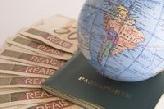
 |
|
| Financial Terms | |
| National Saving |
|
Information about financial, finance, business, accounting, payroll, inventory, investment, money, inventory control, stock trading, financial advisor, tax advisor, credit.
Main Page: business, financial, investment, tax advisor, stock trading, payroll, money, inventory, |
Definition of National Saving
National SavingPrivate saving plus public saving. That part of national income which is not spent on consumption goods or government spending.
Related Terms:Bank for International Settlements (BIS)An international bank headquartered in Basel, Switzerland, which Domestic International Sales Corporation (DISC)A U.S. corporation that receives a tax incentive for Government National Mortgage Association (Ginnie Mae)A wholly owned U.S. government corporation Gross national product (GNP)Measures and economy's total income. It is equal to GDP plus the income International Bank for Reconstruction and Development - IBRD or World BankInternational Bank for Reconstruction and Development makes loans at nearly conventional terms to countries for projects of high International Banking Facility (IBF)International Banking Facility. A branch that an American bank International bondsA collective term that refers to global bonds, Eurobonds, and foreign bonds.  International Depository Receipt (IDR)A receipt issued by a bank as evidence of ownership of one or more International diversificationThe attempt to reduce risk by investing in the more than one nation. By International finance subsidiaryA subsidiary incorporated in the U.S., usually in Delaware, whose sole International Fisher effectStates that the interest rate differential between two countries should be an International fundA mutual fund that can invest only outside the United States. International marketRelated: See external market. International Monetary FundAn organization founded in 1944 to oversee exchange arrangements of International Monetary Market (IMM)A division of the CME established in 1972 for trading financial London International Financial Futures Exchange (LIFFE)A London exchange where Eurodollar futures  London International Financial Futures Exchange (LIFFE)London exchange where Eurodollar futures as well as futures-style options are traded. Multinational corporationA firm that operates in more than one country. National Futures Association (NFA)The futures industry self regulatory organization established in 1982. National marketRelated: internal market NationalizationA government takeover of a private company. Savings and Loan associationnational- or state-chartered institution that accepts savings deposits and Savings depositsAccounts that pay interest, typically at below-market interest rates, that do not have a SIMEX (Singapore International Monetary Exchange)A leading futures and options exchange in Singapore. international Fisher effectTheory that real interest rates in all countries should be equal, with differences in nominal rates reflecting differences in expected inflation. DissavingNegative saving, a situation in which spending exceeds disposable income. Gross National ProductTotal output of final goods and services produced by a country's citizens during a year.  International Monetary Fund (IMF)Organization originally established to manage the postwar fixed exchange rate system. International ReservesSee foreign exchange reserves. National DebtThe debt owed by the government as a result of earlier borrowing to finance budget deficits. That part of the debt not held by the central bank is the publically held national debt. National IncomeGDP with some adjustments to remove items that do not make it into anyone's hands as income, such as indirect taxes and depreciation. Loosely speaking, it is interpreted as being equal to GDP. National Income and Product AccountsThe national accounting system that records economic activity such as GDP and related measures. National OutputGDP. Net National ProductGNP minus depreciation. Private SavingThat part of disposable income not spent on consumption. Publicly Held National DebtSee national debt. Savings Incentive Match Plan for Employees (SIMPLE)An IRA set up by an employer with no other retirement plan and employing fewer than 100 employees, Registered Retirement Savings Plan (Canada)Commonly referred to as an RRSP, this is a tax sheltered and tax deferred savings plan recognized by the Federal and Provincial tax authorities, whereby deposits are fully tax deductable in the year of deposit and fully taxable in the year of receipt. The ability to defer taxes on RRSP earnings allows one to save much faster than is ordinarily possible. The new rules which apply to RRSP's are that the holder of such a plan must convert it into income by the end of the year in which the holder turns age 69. The choices for conversion are to simply cash it in an pay full tax in the year of receipt, convert it to a RRIF and take a varying stream of income, paying tax on the amount received annually until the income is exhausted, or converting it into an annuity with guaranteed payments for a chosen number of years, again paying tax each year on moneys received. Spousal Registered Retirement Savings PlanThis is an RRSP owned by the spouse of the person contributing to it. The contributor can direct up to 100% of eligible RRSP deposits into a spousal RRSP each and every year. Contributing to a spouses RRSP reduces the amount one can contribute to one's own RRSP, however, if the spouse is a lower income earner, it is an excellent way in which to split income for lower taxation in retirement years. Canada Savings BondsA bond issued each year by the federal government. These bonds can be cashed in at any time for their full face value. international fundA mutual fund that can invest in securities issued anywhere outside of Canada. RRSP (Registered Retirement Savings Plan) (Canada)A savings plan registered with Revenue Canada, which allows you to set aside a portion of your earned income now for use in the future. When you contribute to your RRSP, you are eligible to claim a tax deduction. However, cashing RRSPs at a later date will result in the payment of tax. savings fundsMutual funds that seek to preserve capital. This type of fund invests primarily in short-term securities with an average term to maturity of one year or less, or in the case of money market funds, 90 days or less. Non-Smoker DiscountIn October 1996 it was announced in the international news that scientists had finally located the link between cigarette smoking and lung cancer. In the early 1980's, some Canadian Life Insurance Companies had already started recognizing that non-smokers had a better life expectancy than smokers so commenced offering premium discounts for life insurance to new applicants who have been non-smokers for at least 12 months before applying for coverage. Today, most life insurance companies offer these discounts. Related to : financial, finance, business, accounting, payroll, inventory, investment, money, inventory control, stock trading, financial advisor, tax advisor, credit. |